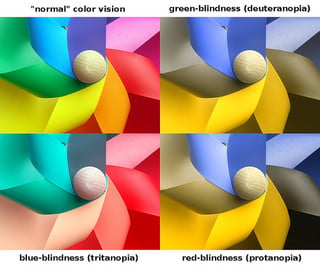
“I’m going to wear my green shirt tonight” my friend tells me. “What green shirt?” I enquire. “The green shirt you bought me for my last birthday” she replies. “But the shirt I bought you was brown” I protest.
Bullshit, she says. Bullshit, I say.
And this is when we both realise my best friend is colour blind.
I’m embarrassed to admit I quickly – and gleefully – started to pull out other brightly coloured items, asking her to tell me what colour she saw. She was wrong, every time.
The below images are a comparison of how non-colourblind (L) and colourblind (R – Dichromat) see the world.
Now, you might think that maybe it's me who's colour blind. But like any good experiment, I relied on a variety of subjects (her husband and children) to be my control and to assure me that yes, my friend was indeed, colour blind. Which in retrospect, explained A LOT from our childhood.
According to Vision Australia, about 8 per cent of males and 0.4 per cent of females are colour blind. Colour blindness is predominantly an inherited condition, and there's no cure. Colours might be confused, and some colours may be seen more dimly.
The thing is, you might be colour blind but still able to function quite normally and therefore, have never picked up on it. You can still drive, still see traffic light changes and move through life without even realising you are seeing the world through a completely different kaleidoscope to your peers.

